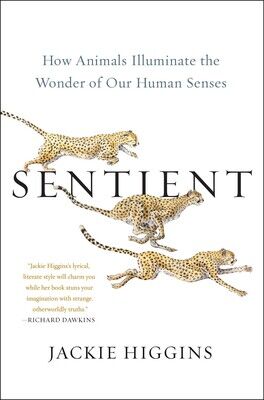Scent
Sentient: How Animals Illuminate the Wonder of Our Senses
A new book discusses the incredible sensory capabilities of 13 animals.
Posted February 15, 2022 Reviewed by Ekua Hagan
Key points
- What humans think of as reality is only a reflection of what their senses can detect, and only a fraction of what is there.
- Nonhuman animals reveal a wider sensory range. For example, orb-weaving spiders show how our eyes sense not only space but the passage of time.
- The idea that humans and only a few other animals are sentient is a myth.

Sentience, the ability to feel, is all around us, and almost daily we learn of the amazing sensory capacities of nonhuman animals (animals), many of whom most people likely wouldn't include in the "sentience club."1 Jackie Higgins' new fascinating book, Sentient: How Animals Illuminate the Wonder of Our Human Senses uses the latest data from comparative studies to investigate our understanding of animal sentience and puts to rest the myth that only we and a few other animals are sentient beings.2,3 I'm pleased she could answer a few questions about her landmark book. Here's what she had to say.
Marc Bekoff: Why did you write Sentient?
JH: Some 25 years ago, I worked at Oxford Scientific Films, a company now regarded as a pioneer in natural history camerawork. My first day in the office was far from typical; it entailed inflicting pain on my new boss. We were reconstructing a killer-bee attack for a National Geographic documentary and needed a close-up of a bee implanting its barbed sting. My boss rolled up his sleeve, showed me how to hold the bee and where on his skin the macro lens was focused.
That day, I learned how the bee released a scent—undetectable to my human nose—designed to summon other bees to strike. Thankfully, there were none nearby, but I would be reminded of this lesson on alarm pheromones when I started keeping bees. On another shoot, this time for the BBC’s Natural World, I discovered how butterflies see colours beyond our imagination.

We also used infrared cameras to give some idea of how rattlesnakes perceive warm-blooded prey and mosaic-like lenses to mimic how houseflies see their surroundings with multifaceted compound eyes. All these projects, and others, fuelled my fascination with how animals sense the world, but the inspiration for Sentient came from the man to whom I submitted my first essay as a university zoology undergraduate.
MB: How does your book relate to your background and general areas of interest?
JH: My tutor at university was Richard Dawkins, perhaps the most famous evolutionary biologist of our day. In Unweaving the Rainbow: Science, Delusion and the Appetite for Wonder, he wrote: ‘There is an anaesthetic of familiarity, a sedative of ordinariness, which dulls the senses and hides the wonder of existence … But we can recapture the sense of having just tumbled out to life on a new world by looking at our own world in unfamiliar ways.’ Non-human animals offer a way to shake off this anaesthetic.
Sentient is ultimately about how we sense the world, but it is told through the eyes, ears, tongues, noses, and skins of other animals. My interest in zoology has always been to understand myself and so much can be learned from the sentient beings with whom we share the planet. The animals in Sentient reveal the surprising ways in which we sense and even make sense of the world.
MB: Who is your intended audience?
JH: I suppose it is every author's wish that their book will have wide appeal. But I wrote Sentient not simply for people interested in nature or in science; indeed my favourite compliments have come from people who have never picked up a nature or a science book before. I wrote it for the curious-minded, for those intrigued by the question of what it means to be human, in all its diversity.
Sentient introduces the reader to a woman who can see millions more colours than most, to a man who lost his sight and with it his sense of time, to another who woke one morning to find he could no longer feel his body whatsoever—with eyes closed, he felt as if he had been disembodied. Sentient explores the wonder and poetry of the natural world and our place within it, proving that there is more to unite us to than divide us from our sentient neighbors.
MB: What are some of the topics you weave into your essay and what are some of your major messages?
JH: I learned that the premise established over two millennia ago by Aristotle that humans have five senses—namely sight, smell, hearing, touch, and taste—is a little more than a Greek myth. Today, the existence of a human ‘sixth sense’—once confined to the realms of pseudoscience, with tales of telepathy or other extrasensory perceptions—is scientific fact. Modern science has shown that we also have a seventh, an eighth, perhaps even a thirtieth sense. Expert opinion differs on the final tally. Some argue it is folly even to individually categorise them because perception is a multisensory experience, whereas others confuse the issue further in day-to-day conversation by invoking senses of love and loss, of guilt and justice, or art and music.
Irrefutably, our eyes, ears, skin, tongue, and nose support more than one way of seeing, hearing, touching, tasting, and smelling. It is beyond question that Aristotle failed to identify the many ‘secret’ senses working beneath his conscious awareness. In Sentient, an orb-weaving spider shows how our eyes sense not only space but also the passage of time. According to a bar-tailed godwit, they may even sense location, much like a compass. Our inner ears hear but also, as the cheetah reveals, sense whether we are balanced. Our tongue smells and our nose tastes. The common octopus highlights how a variant of touch grants us knowledge of our bodies that might even inform our profound perception of self. The book defers to great grey owls, bloodhounds, spookfish, and saturnid moths to open minds to the everyday miracle of being sentient, but then ends with a cautionary tale.
The platypus relies on an electric sense to find its prey. Its bill is covered in tens of thousands of microscopic sensors that can detect the weak electric fields of another. We do not share this sense; electricity exists in the world, but unless it is at amplitudes sufficient to activate our pain sensors, it remains beyond our sphere of sentience. The platypus teaches us that what we think of as reality is only a reflection of what our senses detect and that that is a shockingly small fraction of surrounding reality. We see only a ten trillionth of the electromagnetic spectrum. Imagine extending our range to perceive infrared heat like vampire bats or ultraviolet like birds. Imagine experiencing the taste of a catfish, the touch of a star-nosed mole, the balance of a cheetah. Imagine opening our minds to the platypus’s improbable sense. Ultimately, the natural world might inspire a brave new world of human sentience.
References
Bekoff, Marc. Animal Emotions, Animal Sentience, and Why They Matter.
_____. Sentience is Everywhere: Indeed, It's an Inconvenient Truth.
_____. Spain Joins Other Nations in Declaring Animals Are Sentient.
_____. A Universal Declaration on Animal Sentience: No Pretending.
_____. GUNDA: A New Film on Animal Sentience Recalibrates Morality.
_____. Do Animals Think or Feel?




